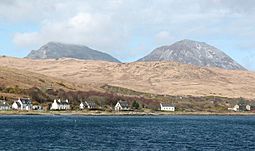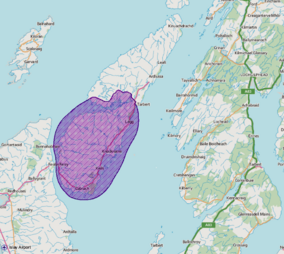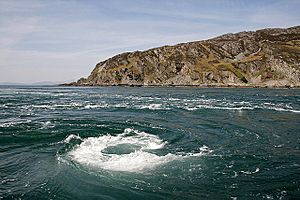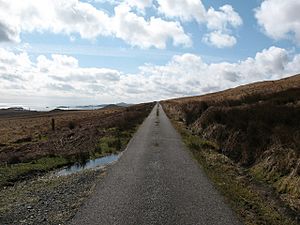Jura, Scotland facts for kids
| Gaelic name | Diùra [ˈtʲuːɾə] |
|---|---|
| Norse name | Dýrey |
| Meaning of name | "deer island" |
 Craighouse from the pier with the Paps of Jura in the background |
|
| OS grid reference | NR589803 |
| Coordinates | 56°N 6°W / 56°N 6°W |
| Physical geography | |
| Island group | Islay |
| Area | 366.92 km2 (142 sq mi) |
| Area rank | 8 |
| Highest elevation | Beinn an Òir, 785 m (2,575 ft) |
| Administration | |
| Sovereign state | United Kingdom |
| Country | Scotland |
| Council area | Argyll and Bute |
| Demographics | |
| Population | 196 (2013) |
| Population density | 0.5/km2 (1.3/sq mi) |
| Largest settlement | Craighouse |
Jura (/ˈdʒʊərə/ JOOR-ə; Scottish Gaelic: Diùra) is a beautiful island in Scotland. It is part of the Inner Hebrides group of islands. Jura is next to and northeast of Islay.
The island covers about 367 square kilometers (142 square miles). In 2011, only 196 people lived there. This makes Jura one of the least crowded islands in Scotland. It is the eighth largest island by size but only the 31st by population. Jura is a mountainous island. It is mostly bare and not very fertile. Large areas are covered by a type of wet land called blanket bog.
The main village on Jura is Craighouse. It is located on the east coast, by the Sound of Jura. In Craighouse, you can find the Jura distillery, which makes famous single malt whisky. A rum distillery also opened there in 2021. The village also has the island's shop, church, primary school, a hotel, a gallery, and petrol pumps.
North of Craighouse are other small places. These include Keils, Knockrome, Ardfernal, Lagg, Tarbert, Ardlussa, and Inverlussa. The famous writer George Orwell lived on Jura from 1946 to 1949. He finished his famous book Nineteen Eighty-Four while staying at a remote farmhouse called Barnhill.
Between Jura's northern tip and the island of Scarba is the Gulf of Corryvreckan. This area has a strong whirlpool that makes boat travel dangerous at certain times. The southern part of Jura is a special National Scenic Area. This means it has beautiful landscapes that are protected.
Contents
- Exploring Jura's Villages and Hamlets
- How Jura Was Formed: Island Geology
- Jura Through Time: A Brief History
- George Orwell's Time on Jura
- Who Owns Jura Today?
- Jura's Economy: How People Make a Living
- Getting Around Jura: Transport
- Wildlife and Nature on Jura
- Stories and Writings About Jura
- Jura's Culture and Music
- Jura and The KLF
- See also
Exploring Jura's Villages and Hamlets
Jura has several small communities. Some are officially listed as settlements by the Ordnance Survey. Others are shown on maps but are smaller.
Main Settlements on Jura
- Ardfernal
- Ardmenish
- Craighouse
- Inverlussa
- Keils
- Kinuachdrachd
- Knockrome
- Lagg
- Leargybreck
- Tarbert
Other Places on Jura
These places are also found on Jura:
- Ardfin
- Ardlussa
- Cabrach
- Feolin Ferry
- Lealt
- Lussagiven
How Jura Was Formed: Island Geology
The island of Jura is mostly made of a very hard rock called Dalradian quartzite. This rock gives the Paps of Jura their jagged, sharp look. The Paps are the island's famous mountains.
Across the western part of Jura, the quartzite rock has many long, thin lines of basalt. These lines are called dikes. They formed about 56 million years ago during a time of strong volcanic activity. You can see these dikes clearly on the west coast. Here, the softer rock around them has worn away. This leaves the harder basalt dikes standing like natural walls. The west coast also has several raised beaches. These are old shorelines that are now higher than the sea. They are important geological features.
Jura Through Time: A Brief History
People have lived on Jura for a very long time. Evidence of settlements from the Mesolithic period (Middle Stone Age) was found in the 1960s. There are also signs of Neolithic (New Stone Age) settlement.
The name "Jura" comes from the Old Norse word Dyrøy. This means "beast island" or "wild animal island." This name was given by the Vikings.
In the 6th century, some believe Jura was the island of Hinba. This is where Saint Columba, a very important Christian leader, went for prayer. He founded a famous monastery on Iona.
Vikings and Scottish Rule
Vikings began to take over the Hebrides islands in the 9th century. Their rule became official in 1098. The Vikings controlled the islands until 1266. That year, the Hebrides, along with Kintyre and the Isle of Man, became part of Scotland. This happened after the Treaty of Perth. A powerful leader during the Viking time was Somerled. His family later became the Lords of the Isles.
The Lords of the Isles and Clans
The Lordship of the Isles was mostly controlled by Clan Donald. Their main home was on Islay. The Lordship ended in 1493. However, the MacDonalds of Dunnyveg continued to rule southern Jura.
The north of the island was owned by Clan Maclean. Their castle was at Aros in Glengarrisdale. In 1647, a battle happened there between the Macleans and the Campbells. For many years, a human skull was kept in a nearby cave. People said it belonged to a Maclean killed in that battle. The skull is no longer there. But maps still show the spot as 'Maclean's Skull Cave'.
The Campbells Take Over
After the Lords of the Isles lost power, the Campbells gained rights to Jura in 1506. The 16th century was a time of fighting between the MacDonalds, Campbells, MacLeans, and other clans. In 1607, the Campbells finally bought the island from the MacDonalds. For about 300 years, the Campbell family largely owned and ruled Jura. The northern part of the island stayed with the MacLeans until 1737. Then, it was sold to Donald MacNeil.
Emigration from Jura
Starting in the mid-1700s, many people began to leave Jura. This was even before the famous Highland Clearances of the 1800s. In 1767, fifty people moved from Jura to Canada. After that, the island's population slowly dropped. It went from over a thousand people to just a few hundred in the 20th century. People left not always by choice. They were often forced to leave because of hunger and rising costs.
George Orwell's Time on Jura
The famous writer George Orwell lived at Barnhill on Jura. He stayed there off and on from 1946. During this time, he was very sick with tuberculosis. Orwell left Jura in January 1949 for medical treatment. He never returned to the island.
Locals knew him by his real name, Eric Blair. He finished his famous book Nineteen Eighty-Four at Barnhill between 1947 and 1948. He sent the final copy to his publishers in December 1948. The book was published in June 1949. Even though Barnhill is very isolated, it has become a special place for his readers.
While on Jura, Orwell and his adopted son, Richard Blair, along with a niece and nephew, almost died. This happened at the Corryvreckan whirlpool. Their boat's motor fell off. They rowed to a small island, Eilean Mòr. Their boat then flipped over as they got out. Luckily, a lobster boat rescued them.
Barnhill is still owned by the Fletcher family, who rented it to Orwell. The four-bedroom house can be rented today. It is quite simple, just as it was in Orwell's time. A generator provides electricity. The small fridge runs on gas. A coal-fired stove provides heat. The house still looks and feels like it did when Orwell lived there.
Who Owns Jura Today?
Today, Jura has seven different estates and a whisky distillery. Each is owned separately.
- Ardfin: This estate is at the southern tip of the island. It was bought in 2010 by Greg Coffey, a manager of investments. The famous walled garden of Jura House, which was once open to visitors, is now closed. A private 18-hole golf course was built on the estate. The old Jura House was made bigger and more modern. Farm buildings were turned into a luxury hotel for golfers. The golf course opened in 2019.
- Inver: This estate is north of Ardfin. It belongs to Sir William Lithgow. He is a leader in a shipbuilding company.
- Jura Forest: Also north of Ardfin, on the east side of the Paps of Jura. This estate belongs to the Vestey family.
- Tarbert: This estate is north of the Corran River. It has been owned by the Astor family for over 100 years. The current owner is a company whose owners are the children of William Astor, 4th Viscount Astor. Former Prime Minister David Cameron has visited this estate many times.
- Ruantallain: This estate is just north of Loch Tarbert. It used to be part of the Tarbert Estate. It is owned by Lindsay Bury, who is a former president of a wildlife charity.
- Ardlussa: This estate is north of Ruantallain. The current owner is Andrew Fletcher. His family lives at Ardlussa House. They are the only estate owners who live on Jura all the time.
- Barnhill: This is at the very northern tip of Jura. It overlooks the famous Corryvreckan Whirlpool. George Orwell finished his novel Nineteen Eighty-Four while living here. Barnhill is also owned by a member of the Fletcher family.
The Jura distillery was first built in 1810. It closed in 1900 and was taken apart. In 1963, two estate owners rebuilt a modern distillery. It is now owned by Whyte & Mackay. There is also a small area of land owned by Forestry and Land Scotland.
Jura's Economy: How People Make a Living
In 2005, a study estimated that Jura's economy made over £3.2 million. The Jura distillery was the biggest business. It also employed the most people. However, the island's seven estates together employed the most full-time and part-time staff. The distillery is now owned by a company from the Philippines.
The estates offer deer stalking and other field sports. They also have forestry and some agriculture. In 2015, a new distillery opened in Ardlussa. It makes Lussa Gin. In 2021, the island's first rum distillery opened in Craighouse. It makes Deer Island Rum. Both are small, local businesses.
Tourism is important to Jura's economy. In 2005, over 20% of the people worked in tourism. The recent pandemic affected this. However, remote working has brought new types of jobs to the island. These include digital and creative jobs. The island's beautiful landscape and wildlife are still big attractions. Visitors enjoy seeing the many red deer. They also like the Paps of Jura mountains and the Corryvreckan whirlpool. Jura is a great place for peace, quiet, and walking.
Modern crofting (small-scale farming) is also important. It helps young families and new housing on the island. In 2013, the Jura Development Trust bought the island's only shop. It is now a community-owned business. The trust is also looking into renewable energy. In 2018, a new business hub opened in Craighouse. It has a photography gallery, the rum distillery, and a craft shop.
Getting Around Jura: Transport
In summer, there is a direct passenger ferry. It goes between Craighouse on Jura and Tayvallich on the Scottish mainland. This service is run privately.
All year round, the MV Eilean Dhiura ferry runs regularly. It goes between Feolin on Jura and Port Askaig on Islay. This service runs often from morning to evening. From Islay, you can take ferries to other places like Kennacraig and Oban. There are also flights from Islay airport to Glasgow Airport and Oban.
Jura has only one main road, the A846. It is a single-track road. It follows the southern and eastern coast from Feolin Ferry to Craighouse. This is about 8 miles (13 km). The road then continues north to Lagg, Tarbert, and Ardlussa. A private track goes even further north. There is a local bus service on the island.
Jura also has five electric vehicle charging points. These are at the whisky distillery, the Village Hall Carpark, and near the petrol pumps.
Wildlife and Nature on Jura

| Jura National Scenic Area | |
|---|---|

A map of the Jura National Scenic Area
|
|
| Location | Argyll and Bute, Scotland |
| Area | 303 km2 (117 sq mi) |
| Established | 1981 |
| Governing body | NatureScot |
Jura is home to a very large number of red deer. These deer eat plants and stop the island from turning back into woodland. Some people think the island's name might even come from the many yew trees that grew there long ago.
Jura is also known for its many birds. Especially for its raptors, like buzzards, golden eagles, white-tailed eagles, and hen harriers. Since 2010, Jura has been a special protected area for golden eagles. The shores of Jura are visited by grey seals. The shy otter is also common here. You might also see the adder, which is the UK's only venomous snake. The seas around Jura are important for Harbour porpoises.
Stories and Writings About Jura
In 1549, Donald Monro, a church leader, wrote about Jura. He said it was a "fine forest for deer." He also mentioned "fresh water lochs" and lots of salmon.
However, in 1632, a soldier named Sir James Turner visited Jura. He was not as impressed. He called it a "horrible island" fit for "deer and wild beasts."
But at the end of the 17th century, the writer Martin Martin visited. He thought Jura was perhaps the healthiest place in Scotland. He noted that people lived very long lives there. He also said that people on Jura rarely got sick with common diseases.
Jura's Culture and Music

Like other inhabited Hebridean islands, Jura has its own tradition of Gaelic songs and poems. Since 1993, Jura has hosted the Jura Music Festival every September.
Jura is also featured in many books. These include A Question of Blood by Ian Rankin (2003) and The Careful Use of Compliments by Alexander McCall Smith (2007). It is also a setting in The Winter Vault by Anne Michaels (2008). The novel Burning Down George Orwell's House by Andrew Ervin is also set on the island.
In music, Jura is the subject of two parts of the Hebridean Suite (1947) by Marie Dare. It is mentioned in songs like "The Bens of Jura" by Capercaillie and "Isle of Jura" by Skyclad. The band Mekons even recorded an album called 'Jura' on the island in 2015.
Jura and The KLF
Jura is also known for a strange event on August 23, 1994. Two musicians, Bill Drummond and Jimmy Cauty, who were part of the group The KLF, filmed themselves burning £1 million in banknotes. This happened in a boathouse on the south coast of the island.
See also
 In Spanish: Jura (isla) para niños
In Spanish: Jura (isla) para niños



